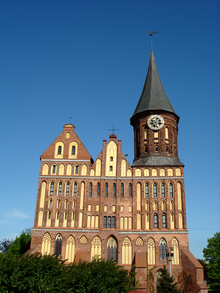| Revision as of 10:16, 23 February 2010 editMattis (talk | contribs)4,265 edits Add Thai interwiki← Previous edit | Revision as of 22:55, 6 March 2010 edit undoDenghu (talk | contribs)Extended confirmed users2,233 editsNo edit summaryNext edit → | ||
| Line 1: | Line 1: | ||
| {{Unreferenced|date=December 2009}} | {{Unreferenced|date=December 2009}} | ||
| ] | ] | ||
| ] | ] | ||
| ] | ] | ||
Revision as of 22:55, 6 March 2010
| This article does not cite any sources. Please help improve this article by adding citations to reliable sources. Unsourced material may be challenged and removed. Find sources: "Königsberg Cathedral" – news · newspapers · books · scholar · JSTOR (December 2009) (Learn how and when to remove this message) |



Königsberg Cathedral (Template:Lang-de; Template:Lang-ru) is a Brick Gothic style building in Kaliningrad (formerly Königsberg) on an island in the Pregel (Pregolya). The island was called Kneiphof in German times.
History
14th Century to World War II
The cathedral was built to replace a smaller cathedral, after Johann Clare, bishop of Sambia, insisted on the construction of a bigger building. The smaller cathedral, situated in Altstadt, was subsequently demolished and materials from it were used to build the new cathedral on Kneiphof.
The construction of the cathedral on Kneiphof is considered to have begun in 1333. The soil on which the cathedral was built was marshy, and so hundreds of oak poles were put into the ground before the actual construction could begin. After the relatively short period of almost 50 years, the cathedral was largely completed by 1380. Work on the interior frescoes lasted until the end of 14th century.
The choir contained murals from the 14th and 15th Centuries, late Gothic wood carvings and medieval monuments in the Renaissance style, the chief of which was a statue of Albert, Duke of Prussia, carved by Cornelis Floris de Vriendt in 1570.
The cathedral originally had two spires. The spires (one north and one south) overlooked the entrance (west side) of the cathedral. But in 1544 the two spires were destroyed by fire. The south spire was rebuilt, but the north spire was replaced by a simple gable roof. In 1640 a clock was built underneath the rebuilt spire, and from 1650 the famous Wallenrodt Library, donated by Martin von Wallenrodt, was situated underneath the gable roof.
In 1695, an organ was installed in the cathedral. In the 19th century, the organ was restored and then renewed.
On 27 September 1523, Johann Briesmann gave the first Lutheran sermon in the cathedral. From then on, until 1945, the cathedral remained Protestant.
Albert, Duke of Prussia, and some of his relatives, as well as other dignitaries, were buried in the cathedral.
Pre World War II photos
-
 Inside the cathedral
Inside the cathedral
-
 The tomb of Albert, Duke of Prussia
The tomb of Albert, Duke of Prussia
- The choir of the cathedral The choir of the cathedral
World War II
In late August 1944, British bombers carried out two night raids on Königsberg. The first raid, on 26/27 August, largely missed the city, but the second raid, on 29/30, destroyed most of the old part of Königsberg (including Kneiphof), and the cathedral was hit. Amongst many others in the city, about a hundred people, mostly children, who had gathered inside the part of the cathedral directly underneath the spire to find safety from the air raid, were killed.
Post World War II
After the war, the cathedral remained a burnt out shell and Kneiphof was made into a park with no other buildings. Before the war, Kneiphof had many buildings. One of the buildings was the first Albertina University building, where Immanuel Kant taught, which was situated next to the east side of the cathedral.
Shortly after Kaliningrad was opened to foreigners in the early 1990s, work began to reconstruct the cathedral. In 1994 a new spire was put in place using a helicopter. In 1995 a new clock was put in place. The clock has four bells (1,180 kg, 700 kg, 500 kg & 200 kg), all cast in 1995. The clock chimes every quarter of an hour. On the hour, the clock chimes by playing the first notes of Beethoven's Symphony No. 5, followed by monotonic chiming to indicate the hour. Between 1996 and 1998, work was done to construct the roof. Work was also done to put in stained glass windows.
One problem during the reconstruction was the subsidence of the cathedral which had happened over time. Even during German times, the subsidence had been evident.
Today, the cathedral has two chapels, one Lutheran, the other Russian Orthodox, as well as a museum. The Lutheran chapel is where the people under the spire died during the second air raid of August 1944. The cathedral is also used for concerts.
Kant's Tomb

The tomb of the philosopher Immanuel Kant, the "Sage of Königsberg", is today in a mausoleum adjoining the northeast corner of the cathedral. The mausoleum was constructed by the architect Friedrich Lahrs and was finished in 1924 in time for the bicentenary of Kant's birth. Originally, Kant was buried inside the cathedral, but in 1880 his remains were moved outside and placed in a neo-Gothic chapel adjoining the northeast corner of the cathedral. Over the years, the chapel became dilapidated before it was demolished to make way for the mausoleum, which was built on the same spot, where it is today.
Other burials
- Heinrich Reuß von Plauen
- Johann von Tiefen
- Martin Truchseß von Wetzhausen
- Stanislovas Rapalionis
- Luther von Braunschweig
54°42′23″N 20°30′42″E / 54.70639°N 20.51167°E / 54.70639; 20.51167
Categories: